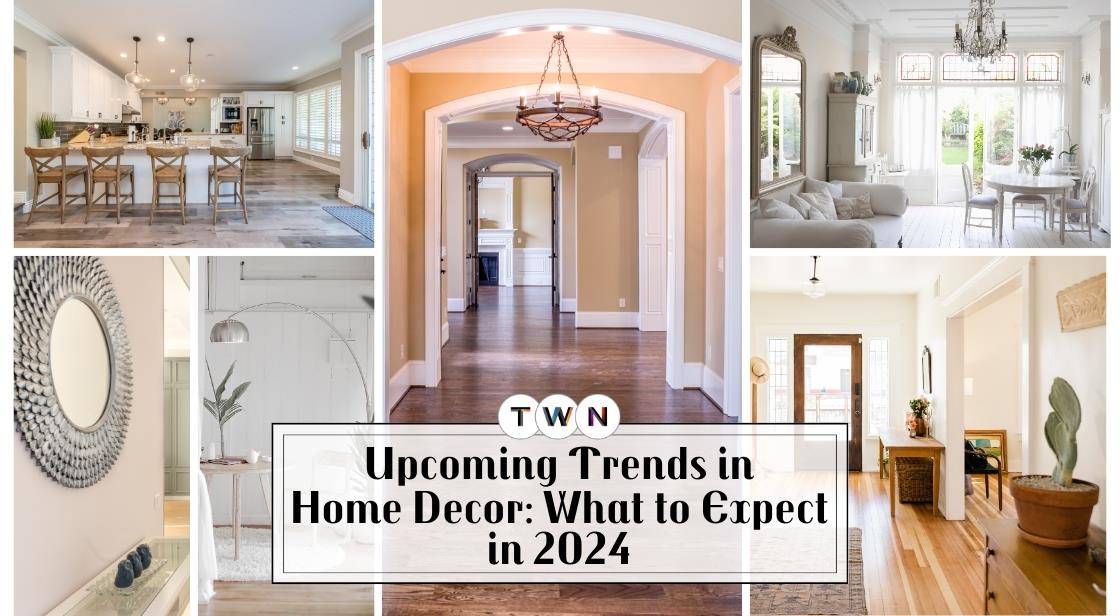Upcoming Trends in Home Decor: What to Expect in 2024

Blog Post
The world of home decor is poised for exciting transformations that blend innovation with timeless appeal. Anticipating upcoming trends reveals a shift towards sustainability and functionality without compromising on style.
In the coming year, expect to see a resurgence of natural materials such as wood, rattan, and bamboo, as homeowners prioritize eco-friendly choices that bring a sense of warmth and connection to nature indoors. Sustainability isn't just a trend but a guiding principle, influencing everything from furniture design to textile choices.
Color palettes are set to evolve, with soothing earth tones like sage green, terracotta, and muted blues gaining popularity, fostering a calming atmosphere within living spaces. These hues not only complement natural materials but also create a serene backdrop conducive to relaxation and mindfulness.
Technological integration will continue to shape home decor, with smart home devices seamlessly blending into interior designs. From intelligent lighting systems to multifunctional furniture that incorporates charging ports, the emphasis is on enhancing convenience while maintaining aesthetic appeal.
Furthermore, versatility and adaptability will be key considerations in furniture design, catering to the growing trend of multi-functional living spaces. Pieces that can serve dual purposes or are easily reconfigurable will be favored, accommodating the evolving needs of modern lifestyles.
2024 promises to be a year where sustainability, functionality, and aesthetic appeal converge harmoniously in home decor, offering homeowners a plethora of choices to create spaces that are both stylish and mindful of the environment.
Discovering the Latest Decor Trends for 2024: Elevate Your Home
In today's dynamic world of interior design, staying abreast of home decor trends is not merely about aesthetics but also about creating spaces that reflect personal style, enhance functionality, and foster well-being. As trends evolve, they influence how we perceive and interact with our living environments, making it essential to remain informed and adaptable. This article delves into the importance of keeping up with these trends and provides a glimpse into what can be expected in home decor for 2024.
Importance of Staying Updated with Home Decor Trends
Understanding current trends in home decor enables homeowners to infuse their spaces with contemporary flair while maintaining timeless appeal. It empowers individuals to make informed decisions about colors, materials, and design elements that align with their lifestyle and preferences. Moreover, staying updated with trends ensures that homes remain relevant and appealing, whether for personal enjoyment or potential resale value. By incorporating trending styles and innovations, homeowners can create environments that are both visually appealing and functional, optimizing the use of space and enhancing daily living experiences.
Sustainable and Eco-Friendly Materials
By embracing sustainable and eco-friendly materials, homeowners not only enhance their living spaces aesthetically but also contribute positively to global environmental goals. These choices reflect a growing awareness of sustainability in home decor, encouraging a shift towards more responsible consumption and design practices.
Increasing Popularity of Sustainable Decor Choices: Sustainable decor choices have gained traction as more homeowners prioritize environmental responsibility. These materials contribute to reducing carbon footprints and promoting eco-conscious living.
Trends in Eco-Friendly Materials:
-
Reclaimed Wood: This material is sourced from old buildings, furniture, or other structures, offering a rustic charm while reducing the demand for new wood.
-
Bamboo: Known for its rapid growth and renewability, bamboo is used in furniture, flooring, and decor items due to its durability and aesthetic appeal.
-
Recycled Materials: Glass, plastic, and metal recycled into new products reduce waste and showcase innovative design solutions.
Examples of Incorporation:
-
Furniture: Reclaimed wood can be used for tables, chairs, and bed frames, adding character and sustainability to interiors.
-
Flooring: Bamboo flooring provides a durable and visually appealing alternative to traditional hardwood floors.
-
Decor Accessories: Decorative items like vases, picture frames, and sculptures made from recycled materials offer unique focal points while promoting environmental stewardship.
Biophilic Design and Nature-Inspired Elements
Biophilic design focuses on integrating natural elements into interior spaces to enhance well-being and connection with the natural world. This trend acknowledges the human need to interact with nature, even in urban environments.
Indoor Plants: Greenery and Air Purification
Indoor plants play a crucial role in biophilic design by introducing greenery and improving indoor air quality. Popular choices include low-maintenance plants like pothos, spider plants, and snake plants, which thrive indoors and require minimal care.
Living Walls: Vertical Gardens as Focal Points
Living walls or vertical gardens are innovative solutions to incorporate nature into interiors. These installations not only serve as visually appealing focal points but also contribute to air purification and acoustic benefits, making them ideal for urban settings.
Natural Textures: Bringing the Outdoors In
Using natural textures such as wood, stone, and natural fibers like jute and wool creates a tactile connection to nature. Wooden furniture, stone countertops, and woven rugs or cushions add warmth and depth to spaces, promoting a sense of calm and comfort.
Tips for Creating a Calming Environment
-
Maximize Natural Light: Enhance spaces with ample natural light to mimic outdoor conditions and boost mood.
-
Choose Earthy Colors: Opt for earthy tones like greens, browns, and blues in decor to evoke natural landscapes.
-
Integrate Water Elements: Incorporate water features like indoor fountains or small ponds to evoke tranquility and relaxation.
-
Mindful Placement: Strategically place plants and natural elements to create a harmonious flow and balance within interiors.
By embracing biophilic design principles and incorporating nature-inspired elements, homeowners can create rejuvenating and serene environments that promote well-being and connectivity with the natural world.
Smart Home Integration
Technology in modern home decor not only improves convenience and security but also offers opportunities to personalize living spaces while maintaining aesthetic appeal and sustainability. Smart home integration continues to evolve, offering homeowners innovative ways to enhance their living environments through seamless automation and intelligent design solutions.
Introduction to Technology in Home Decor:
-
Technology plays a pivotal role in modern home decor by integrating smart devices that enhance both functionality and aesthetics.
Trends in Smart Home Devices:
-
Smart Lighting: LED strips and bulbs that can be adjusted for brightness and color, improving ambience and saving energy.
-
Automated Systems: Systems controlling HVAC, security cameras, and appliances remotely, improving convenience and security.
-
Voice-Controlled Assistants: Devices like Amazon Alexa and Google Assistant manage tasks via voice commands, streamlining daily routines.
Enhancing Functionality:
-
Smart thermostats adjust temperatures based on occupancy and weather conditions, optimizing comfort and energy savings.
-
Automated blinds or curtains adjust to natural light levels, enhancing privacy and light management throughout the day.
Aesthetics in Home Design:
-
Smart mirrors with built-in lighting and temperature displays that blend functionality with modern aesthetics.
-
Hidden speakers and sound systems integrated into walls or ceilings, preserving clean lines while providing immersive audio experiences.
Future Prospects:
-
Advancements in AI and IoT (Internet of Things) will likely introduce more intuitive and responsive smart home devices, further enhancing the integration of technology into home decor.
-
The trend towards sustainability and energy efficiency will influence the design of smart devices, promoting eco-friendly solutions in modern home settings.
Minimalism with a Twist
This structure provides a comprehensive overview of how minimalism has evolved to embrace warmth and personalization in 2024, offering practical tips for achieving this aesthetic while maintaining the core principles of simplicity and functionality.
Evolution of Minimalism in 2024
Definition and Origins: Briefly define minimalism as a design philosophy focused on simplicity, clean lines, and functionality.
Shift Towards Warm Minimalism: Discuss the evolution of minimalism in 2024, highlighting the trend towards incorporating warmth and personalization.
Also Read: Best Interior Design Tips for Stunning Home Decor
Warm Minimalism: Soft Colors, Textures, and Natural Light
-
Color Palette: Explore the use of warm neutrals such as beige, taupe, soft greys, and muted pastels in walls, furniture, and decor.
-
Texture Play: Emphasize the importance of textures like wool, linen, velvet, and natural fibers to add depth and tactile appeal to minimalist spaces.
-
Natural Light: Discuss maximizing natural light through large windows, light-filtering curtains, and reflective surfaces to create a sense of openness and airiness.
Achieving a Minimalist Aesthetic with Warmth and Personality
-
Decluttering: Tips on effective decluttering to maintain the minimalist aesthetic while showcasing personal items and collections strategically.
-
Furniture Selection: Choosing furniture with clean lines and functional design, focusing on quality over quantity.
-
Personal Touches: Incorporating personal touches such as artwork, family photos, or handmade decor items to infuse personality intominimalist spaces.
Practical Tips for Implementation
-
Storage Solutions: Utilizing smart storage solutions like built-in cabinets, under-bed storage, and multi-functional furniture to minimize visual clutter.
-
Lighting Design: Opting for ambient lighting fixtures that complement the minimalist style while enhancing warmth and ambiance.
-
Room Layout and Flow: Arranging furniture to create open, inviting spaces that promote relaxation and tranquility.
Benefits of Warm Minimalism
-
Enhanced Comfort: How warm minimalism creates a cozy and inviting atmosphere without sacrificing simplicity.
-
Visual Appeal: Discuss how the blend of soft colors, textures, and natural elements can make spaces visually appealing and timeless.
-
Psychological Impact: The positive effects of minimalist environments on mental well-being, promoting clarity of mind and reducing stress.
Artisanal and Handcrafted Pieces
The trend towards artisanal and handcrafted decor items highlights a preference for authenticity, quality craftsmanship, and supporting local communities. These unique pieces not only enhance the aesthetic appeal of interiors but also embody a deeper appreciation for tradition, creativity, and sustainable living practices.
Rise of Artisanal Craftsmanship Artisanal craftsmanship has become increasingly popular in home decor as consumers seek unique and authentic pieces that showcase skilled craftsmanship and individuality. This trend emphasizes the value of handmade items over mass-produced alternatives.
Appeal of Unique, One-of-a-Kind Pieces Handcrafted decor items hold a special appeal due to their exclusivity and personal touch. They add a sense of authenticity and character to interiors, distinguishing them from mainstream decor found in retail stores. The uniqueness of each piece often becomes a focal point in room design, sparking conversation and reflecting the homeowner's distinctive taste.
Supporting Local Artisans There's a growing appreciation for supporting local artisans and small-scale craftsmen who create these handmade pieces. By purchasing from local artisans, homeowners contribute to the preservation of traditional crafts and support sustainable practices. This trend promotes a connection between consumers and creators, fostering a sense of community and cultural appreciation.
Examples of Handcrafted Decor Items
Handcrafted Furniture: furnishings built to order from premium components like metal, wood, or natural textiles. Custom designs and elaborate features made to the homeowner's specifications are frequently seen in these items.
Pottery and Ceramics: Unique pottery items like vases, bowls, and plates created using traditional techniques such as wheel throwing or hand molding. Each piece showcases the artisan's skill and creativity, offering functional beauty to tabletops and shelves.
Textiles and Weavings: Handwoven rugs, tapestries, and cushions crafted from natural fibers like wool, cotton, or silk. These textiles feature intricate patterns and textures that add warmth and visual interest to living spaces.
Artwork and Sculptures: Handcrafted artworks including paintings, sculptures, and wall hangings created by local artists. These pieces not only enhance aesthetic appeal but also express cultural influences and artistic expressions unique to their creators.
Resurgence of Bold Colors and Statement-Making Decor Elements
In recent years, there has been a notable resurgence in the use of bold colors and statement-making decor elements in interior design. Homeowners and designers alike are increasingly drawn to vibrant hues and eye-catching pieces that add personality and visual interest to living spaces.
Trends in Vibrant Hues and Bold Patterns
Color Psychology: Bold colors such as emerald green, deep blues, mustard yellow, and rich purples are being embraced for their ability to evoke specific emotions and create dramatic focal points within rooms.
Graphic Patterns: Geometric prints, abstract designs, and large-scale patterns on wallpapers, rugs, and upholstery are trending. These patterns not only add visual intrigue but also contribute to the overall aesthetic of a space.
Mixing Textures: Combining bold colors with different textures like velvet, leather, or metallic finishes enhances depth and sophistication, making each piece stand out while maintaining a cohesive look.
Tips on Incorporating Bold Colors and Statement Pieces
Feature Wall: Opt for a feature wall painted in a bold color or adorned with bold wallpaper. This focal point draws attention and anchors the room without overwhelming the entire space.
Statement Furniture: Invest in one or two statement furniture pieces, such as a vibrant sofa, an intricately designed armchair, or a bold coffee table. These pieces serve as functional art pieces that instantly elevate the room's style.
Accents and Accessories: Introduce bold colors through smaller accents and accessories like throw pillows, artwork, vases, or decorative objects. These items can be easily swapped out to refresh the look over time.
Balanced Color Palette: Pair bold colors with neutral tones like white, grey, or beige to create a balanced and harmonious color palette. This approach prevents the space from feeling too overwhelming while allowing the bold elements to shine.
Natural Light and Space Planning: Utilize natural light to soften the impact of bold colors and ensure adequate space planning to maintain flow and functionality within the room.
Trend Towards Personalization and Customization
In recent years, there has been a significant shift towards personalizing interiors to reflect individual tastes and preferences. This trend goes beyond mere decoration to encompass the creation of spaces that feel uniquely tailored to the homeowner's lifestyle and personality.
Custom Furniture
Custom furniture allows homeowners to design pieces that perfectly fit their space and functional needs. Whether it's a bespoke sofa tailored to specific dimensions or a dining table crafted from preferred materials, custom furniture ensures both style and practicality. Collaborating with furniture makers or designers allows for choices in upholstery, finishes, and structural elements, resulting in pieces that are not only aesthetically pleasing but also functional.
Bespoke Design Solutions
Bespoke design solutions extend beyond furniture to encompass entire room layouts and architectural elements. This includes custom-built cabinetry, shelving units, and built-in storage solutions tailored to optimize space usage while aligning with the homeowner's aesthetic preferences. Working with interior designers or architects facilitates the creation of cohesive interiors that blend personalized touches with professional expertise in spatial planning and design principles.
DIY Projects
DIY projects provide an avenue for homeowners to inject their personality into decor through hands-on creativity. From repurposing old furniture with new upholstery or paint finishes to crafting unique decor accents like handmade artworks or personalized photo displays, DIY projects add a personal touch to interiors. They offer flexibility in design choices and allow individuals to showcase their craftsmanship while creating sentimental value within their living spaces.
Tips for Incorporating Personal Touches
Maintaining cohesion and balance in decor while incorporating personal touches is key to achieving harmonious interiors:
-
Color Palette Consistency: Use a consistent color palette throughout the space to tie together diverse elements, ensuring visual harmony.
-
Mixing Styles Thoughtfully: Blend personal heirlooms or eclectic finds with contemporary or traditional decor styles, ensuring they complement rather than clash.
-
Layering Textures: Introduce tactile variety through textiles, rugs, and materials to add depth and visual interest without overwhelming the space.
-
Curating Collections: Display personal collections or travel souvenirs in curated vignettes or gallery walls to tell a story and evoke memories.
-
Functional Personalization: Focus on functional aspects like storage solutions or ergonomic furniture arrangements that cater to daily routines and preferences.
Must-Have Home Decor Items for 2024 and Beyond
Gone are the days of generic decor! In 2024 and beyond, home design is all about creating a personalized and functional space that reflects your unique style and fosters well-being. To elevate your living areas, consider incorporating these essential home decor items, all incorporating the latest trends:
1. Sustainable and Textured Elements:
- Eco-conscious Materials: Embrace sustainability with natural materials like woven baskets, jute rugs, and reclaimed wood furniture. These elements add warmth, texture, and a touch of earthy elegance to your space.
- Biophilic Design: Introduce the outdoors in with potted plants that purify the air and add pops of color. Consider low-maintenance options like snake plants or air plants for effortless greenery.
2. Multifunctional Furniture and Space-Saving Solutions:
-
Smart Furniture: Invest in furniture that serves multiple purposes, like ottomans with storage compartments or coffee tables with hidden shelves. Maximize space in smaller apartments with clever solutions like modular furniture or Murphy beds.
- Vertical Gardens: Utilize vertical space with hanging planters or living walls for a unique biophilic touch. These solutions are perfect for creating a statement piece or adding greenery in compact areas.
3. Statement Lighting with a Focus on Ambiance:
-
Layered Lighting: Move beyond a single overhead light. Combine ambient lighting with task lighting (think reading lamps) and accent lighting (like table lamps or sconces) to create a layered and inviting atmosphere.
- Warm and Smart Lighting: Opt for warm white LED bulbs that create a relaxing ambiance. Consider smart lighting solutions that allow you to control brightness and color temperature remotely, further enhancing the mood and functionality of your space.
4. Personalized Touches for a Uniquely You Aesthetic:
-
Vintage Finds and Heirlooms: Incorporate vintage furniture, artwork, or family heirlooms to inject your personality into your space. These pieces tell a story and create a sense of warmth and comfort.
- DIY Projects and Handmade Accents: Showcase your creativity with DIY projects like throw pillows, decorative wall hangings, or artwork. Handmade pieces add a personal touch and reflect your unique style.
5. Technology that Enhances Comfort and Convenience:
- Smart Home Devices: Integrate smart home devices like smart thermostats, voice-activated assistants, or smart lighting systems for added convenience and control over your environment.
- Hidden Tech Integration: Consider discreetly mounting TVs behind artwork that swivels out for viewing. This keeps the TV from dominating the space and creates a cleaner visual aesthetic.
By incorporating these essential home decor items, you can transform your living spaces into functional, stylish, and personalized havens that reflect your individuality and promote well-being. Remember, the most important aspect of home decor is creating a space that feels comfortable and inspiring to you.
You May Like
EDITOR’S CHOICE












